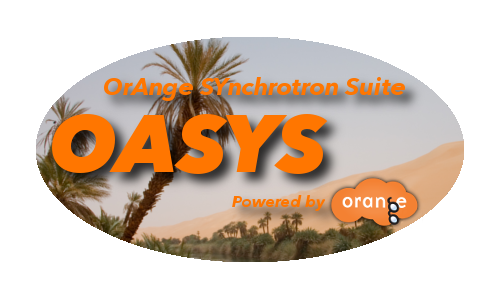|
|
|
The evolution of the hardware platforms, the modernization of the software tools, the access to the codes by a large number of young people and the popularization of the open source software for scientific applications drove Dr. Luca Rebuffi (ANL) and Dr. Manuel Sanchez Del Rio (ESRF) to design OASYS (ORange SYnchrotron Suite), a completely new graphical environment for modeling beamlines and X-ray experiments. The implemented software architecture allows to obtain not only an intuitive and very-easy-to-use graphical interface, but also provides high flexibility and rapidity for interactive simulations, allowing to make quick configuration changes to compare multiple beamline configurations. Its purpose is to integrate in a synergetic way the most powerful calculation engines available. OASYS integrates different simulation strategies via the implementation of adequate simulation tools for X-ray Optics (e.g. ray tracing and wave optics packages). It provides to several tools a language let communicate by sending and receiving encapsulated data. Python has been chosen as the main programming language, because of its universality and popularity in scientific computing. The software Orange, developed at the University of Ljubljana (SLO), is the high level workflow engine that provides the interaction with the user and communication mechanisms. OASYS itself looks like an empty container. APIs are released as distinct groups of widgets called Add-Ons, and the can be installed, uninstalled or upgraded by a using a specific form (Add-On manager): the list of available APIs is shown and the user can customize its OASYS appearance. Add-Ons are python packages that follow the Python Package Index (Pypi) specifications, and they are all uploaded in the Pypi database. OASYS automatically detect when one or more Add-Ons have a newer version in the Pypi database, and propose to the user the upgrade them, in order to keep the installed APIs always at their last release. The available APIs are: ShadowOui, SRW, XOPPY (XOP in PYthon), XRayServer, DABAM. An video introduction to OASYS can be found here |
| Distribution & Impact |
|
General and Installation instructions are available at OASYS INSTALLATION WIKI PAGE.
The release already includes ShadowOui, the OASYS user interface for shadow3, the ray-tracing simulation software, and XOPPY, the python version of XOP.
Shadow3 Tutorials for ShadowOui are available at: https://github.com/oasys-kit/ShadowOui-Tutorial |
| Please cite |
|
For OASYS: L. Rebuffi, M. Sanchez del Rio, "OASYS (OrAnge SYnchrotron Suite): an open-source graphical environment for x-ray virtual xperiments”, Proc. SPIE 10388, 103880S (2017). DOI: 10.1117/12.2274263 For SHADOWOUI: L. Rebuffi, M. Sanchez del Rio, "ShadowOui: A new visual environment for X-ray optics and synchrotron beamline simulations”, J. Synchrotron Rad. 23 (2016). DOI:10.1107/S1600577516013837 |
| Related Publications |
|
D.Cocco, G.Cutler, M.Sanchez del Rio, L.Rebuffi, X.Shi, K.Yamauchi, "Wavefront preserving X-ray optics for Synchrotron and Free Electron Laser photon beam transport systems", Physics Reports 974 (2022). DOI: 10.1016/j.physrep.2022.05.001 L. Rebuffi, X. Shi, "Advanced simulation tools in the OASYS suite and their applications to the APS-U optical design", Proc. SPIE 11493, 1149303 (2020). DOI: 10.1117/12.2567501 L. Rebuffi, X. Shi, M. Sanchez del Rio, R. Reininger, "A ray-tracing algorithm for ab initio calculation of thermal load in undulator-based synchrotron beamlines", J. Synchrotron Rad. 27 (2020). DOI: 10.1107/S160057752000778X M. Sanchez del Rio, R. Celestre, M. Glass, G. Pirro, J. Reyes Herrera, R. Barrett, J. Cesar da Silva, P. Cloetens, X. Shi and L. Rebuffi, "A hierarchical approach for modeling X-ray beamlines: application to a coherent beamline", J. Synchrotron Rad. 26 (2019). DOI: 10.1107/S160057751901213X M. Sanchez del Rio, L. Rebuffi, "OASYS: A software for beamline simulations and synchrotron virtual experiments", AIP Conference Proceedings 2054, 060081 (2019). DOI: 10.1063/1.5084712 L. Rebuffi, M. Sanchez del Rio, E.Busetto and P. Scardi, "Understanding the instrumental profile of synchrotron radiation X-ray powder diffraction beamlines", J. Synchrotron Rad. 24 (2017). DOI: 10.1107/S1600577517005434 L. Rebuffi, M. Sanchez del Rio, "Interoperability and complementarity of simulation tools for beamline design in the OASYS environment”, Proc. SPIE 10388, 1038808 (2017). DOI: 10.1117/12.2274232 M. Sanchez del Rio, D. Bianchi, D. Cocco, M. Glass, M. Idir, J. Metz, L. Raimondi, L. Rebuffi, R. Reininger, X. Shi, F. Siewert, S. Spielmann-Jaeggi, P. Takacs, M. Tomasset, T. Tonnessen, A. Vivo and V. Yashchuk, "DABAM: an open-source database of X-ray mirrors metrology", J. Synchrotron Rad. 23 (2016). DOI: 10.1107/S1600577516005014 M. Sanchez del Rio, L. Rebuffi, J. Demšar, N.Canestrari and O. Chubar, "A proposal for an open source graphical environment for simulating X-ray optics", Proc. SPIE 9209, 92090X (2014). DOI: 10.1117/12.2061834 |

